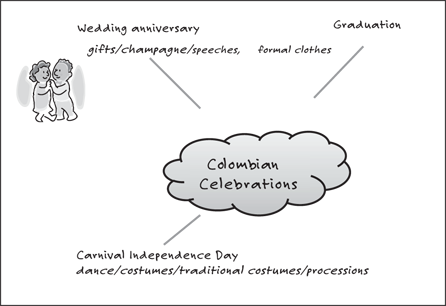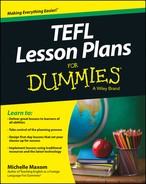Chapter 12
Thinking Outside the Book
In This Chapter
![]() Deciding when to put the course book aside for a while
Deciding when to put the course book aside for a while
![]() Using course book features in unusual ways
Using course book features in unusual ways
![]() Preparing students to anticipate a course book topic in a pre-intermediate lesson plan
Preparing students to anticipate a course book topic in a pre-intermediate lesson plan
In Teaching English as a Foreign Language For Dummies (Wiley) I wrote about using a course book and why it’s often beneficial to do so instead of creating all your own materials. Basically, using a course book is less time-consuming for the teacher because it reduces planning time, it usually contains a logical course syllabus and the book enables you to draw on the experience and research of well-informed teacher-authors.
In this chapter, however, I show you what to do if the course book isn’t meeting your students’ needs. I give you suggestions for eliminating, expanding on, and substituting the material in the book.
Building on Course Books as a Lesson Resource
What do course books usually contain? This list covers the typical features:
- A syllabus
- Practice exercises
- Discussion/writing questions
- Photographs and images
- Grammar boxes with rules
- Extended grammar reference sections
- Verb tables
- Glossaries for particular exercises
- Extended word lists
- Material for communicative activities
- Scripts of listening texts
- Answer keys (in the students’ book or teachers’ book)
- Short reading texts
- A CD/ DVD with listening texts
When you take the course book apart, figuratively speaking, and think about ways of manipulating its features, you tend be more creative.
- You realise that your students already know the topic so there will be no challenge or new input for them.
- The students aren’t ready for the lesson because they haven’t mastered some of the basic principles embodied in it.
- The course book is out-of-date so the information it presents is no longer accurate.
- The course book presentation is rather boring.
- Students have a negative attitude to learning from the book.
- Students have no need to learn a particular language point.
- The book doesn’t have a broad enough range of activities.
- You can cover more information in the time permitted without the book.
- The book presents only one point of view when the students would enjoy exploring other angles.
- Students seem to be too book oriented and unable to see speaking as the language as a real life skill.
- You need to help students develop a particular skill, such as speaking or reading, in a more in-depth way.
Having said all that, you need to be ready with strategies for overcoming these problems. Finding supporting materials and resources is the first step. So be aware that you need all kinds of reading books, magazines, examples from the Internet, CDs and DVDs to enhance lessons. Of course, if these things aren’t available, you can still use realia, drawings, personal anecdotes, and students’ own experiences to create interest. Flick to the table of contents of this book to find chapters dedicated to all kinds of different ways to approach learning beyond the course book.
For this lesson plan I use as an example the class I’m working with at the time of writing and their course book. It’s a class of pre-intermediate general English students aged 20 to 60 (some of the students would qualify for an intermediate class if their speaking ability were stronger). The majority are artists and designers of some kind and they’re from four countries. The book for this class has a wide range of activities and topics. However, my students don’t feel that their lessons are fun when they’re tied to the book. So during a three-hour lesson I often delay using the book for the first hour at least, but subtly prepare students for the topic or grammar the book contains. In this case the students will be studying a unit on special days.
Lesson overview
Doing a warmer activity
![]() 10 minutes
10 minutes
Find out what students know about the musician Stevie Wonder and his many hit songs. Ask students to listen carefully to a song and write down any special days people celebrate that are mentioned. Then play ‘I Just Called to Say I Love’ on CD or on YouTube. Students compare their answers and then listen again while reading the lyrics (play the video with lyrics or print them). The singer specifically mentions a wedding, New Year’s Day, and Halloween, but there are other enjoyable ideas for a good day too. Make sure students understand the meaning of the three main celebrations days.
Comparing cultures
![]() 15 minutes
15 minutes
Give students some A3 paper and pens and put them in groups of those from similar cultures. The students create a poster showing the special days most people celebrate in their cultures, as I show in Figure 12-1.

Figure 12-1: Example of initial poster preparation showing celebrations.
Next the students share their posters by laying them out on a table or along the floor. In this way, the entire class can look and compare the celebration events on each poster. The students then browse and ask other classmates about any celebrations they don’t recognise.
Describing ways of celebrating
![]() 10 minutes
10 minutes
While the students are preparing and comparing posters, put all these celebration words on the board, leaving a little space in between them. I underline the stressed syllables here.
champagne
cakes
balloons
gifts
confetti
flags
banners
candles
face paint
fancy dress
formal dress
traditional costume
songs
fireworks
bonfires
processions
After discussing the posters, the students focus on these words. Ask students to come to the board and draw explanatory pictures next to any words they understand. Have a picture ready for the more difficult words such as processions, just in case. Make sure the meanings of the words are clear and that you drill the pronunciation.
Allow the students to add words that describe other forms of celebration in general (such as party and feast) or something important to their own cultural celebrations, such as piñata, garland or lantern. They can use a dictionary to find out whether an English translation exists or not, but they ought to explain the meaning of the additions they make.
![]() 10 minutes
10 minutes
Students now go back to their poster teams and on the poster write under each celebration the appropriate words for celebrating it. Figure 12-2 shows an example of a completed poster.

Figure 12-2: Example of poster preparation showing ways of celebrating.
Get feedback by asking individual students’ questions, such as, When do people wear special costumes in your culture?
Put the posters on display in the classroom for future reference
![]() 10 minutes
10 minutes
Take a question from the course book without referring to the book itself: What’s the most special day of the year for you? Why? Then add your own question: How do you celebrate it? In pairs students discuss this for five minutes with the help of the vocabulary on the board and the posters.
Stop the students after five minutes and create new pairs. They must now relate to the new partner what their previous partner had said.
Thinking about photos
![]() 10 minutes
10 minutes
Show students a photo of a particularly unusual festival, such as the Gloucestershire Cheese Rolling Festival. Ask the class some ‘wh’ questions (What is it? Where is it? Why did it begin?).
After finally explaining the photograph (the cheese rollers follow the tradition of chasing a cheese round down a steep hill, which involves an awful of lot tumbling!), instruct students to turn to the correct page in the course book but to fold the following page over so that the corresponding reading is concealed. In pairs the students discuss the photographs on the page and ask each other, Which celebrations do you think the pictures represent and why?
Extension activities
The course book contains a reading text about three special days. You may do the exercises in the book during class time, but for homework, students can write some questions about the reading that the book doesn’t answer. For example, after reading about World Teachers’ Day, a student may note the questions: Do people celebrate World Teachers’ Day in Europe? What do they do?
The students can then swap questions and research the answers on the Internet at the beginning of the next lesson.

 Just because your students have a course book, it doesn’t mean you have to use it all the time or follow exactly what it says. In fact, here are some reasons why you may deliberately choose to ‘go rogue’ with the book:
Just because your students have a course book, it doesn’t mean you have to use it all the time or follow exactly what it says. In fact, here are some reasons why you may deliberately choose to ‘go rogue’ with the book: Find ways to use a scaffolding technique with the course book material too and that means you need to provide support for the students before they can approach a task. For example, before jumping into the book, survey the students on what they know about the topic or set them a research task on it to prepare them.
Find ways to use a scaffolding technique with the course book material too and that means you need to provide support for the students before they can approach a task. For example, before jumping into the book, survey the students on what they know about the topic or set them a research task on it to prepare them.